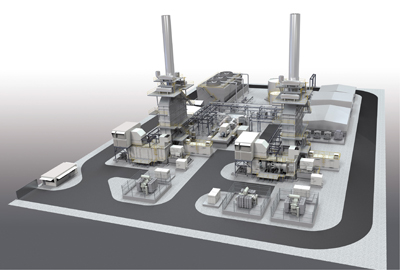Kawasaki is placing on the market, a 100MW Class Gas Turbine Combined Cycle Power Plant (CCPP) Boasting the World’s Highest Level of Electrical Efficiency
Mar. 22, 2018

Tokyo, March 22, 2018 — Kawasaki Heavy Industries, Ltd. announced today that it has completed development of a combined cycle power plant (CCPP) boasting the world’s highest level of electrical efficiency and will now commence marketing activities. The CCPP employs the L30A model, a 30 MW class made-in-Japan high-efficiency gas turbine featuring the highest output of all of Kawasaki gas turbines.
A CCPP consists of 2 stages of power generator facilities. Primary power generation is done by gas turbine generator, and gas turbine exhaust is utilized as a heat source of a heat recovery steam generator (HRSG). Steam from that HRSG rotates a steam turbine generator as a secondary power. A CCPP has shorter startup time than a conventional steam turbine power plant of the same output and features excellent load response as well as high electrical efficiency. High electrical efficiency means minimal thermal energy discarded.
The newly developed CCPP is composed of two L30A gas turbines, two HRSGs, and one steam turbine, all produced by Kawasaki to make the CCPP a Kawasaki original power plant. Kawasaki brings together product technology and plant engineering capabilities cultivated over many years to achieve high efficiency in the combined cycle as a whole in addition to gas turbines alone*1. Total Electrical efficiency is 55.2% (reheat type*2) in the 100 MW class and 54.4% in the 90 MW class, both among the world’s highest levels of electrical efficiency.
Kawasaki has delivered more than 12,000 gas turbines for power generation, 67 HRSGs, and more than 370 steam turbines around the world, building reliability backed by vast experience and a strong track record.
The world’s electrical power consumption is expected to increase in the coming years, with much of the increase occurring in Southeast Asia, which is seeing rapid economic growth. In addition to conventional natural gas output, the number of new shale gas supplier countries other than the United States is expected to increase as well. As a result, demand for construction of gas-fired thermal power plants will grow, and the CCPP market is also anticipated to expand in terms of both capacity and regions. In the distributed energy system market, where power producers are introducing new facilities and updating existing ones at an increasing rate due to factors such as expanded use of unstable renewable energy sources, there are marked demands for highly efficient equipment and excellent load responsiveness. Kawasaki’s CCPP should be able to respond to those demands.
Kawasaki intends to continue to make full use of its sales offices throughout Europe and Asia as the company actively expands its global energy business.
- *1
- Some of the technologies for increasing efficiency and improving load responsiveness of L30A gas turbines were developed by the New Energy and Industrial Technology Development Organization’s (NEDO) Program for Strategic Innovative Energy Saving Technology.
- *2
- This is a reheat type CCPP, in which steam is extracted from the middle stage of a steam turbine and reheated in the reheater of an HRSG before being returned to the steam turbine in order to increase output.
Contact
If you need more information about our business,
please feel free to contact us.





